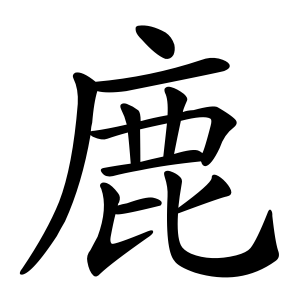鹿
- deer;
Etymology
It is a pictograph modeled after the shape of a male deer, showing its antlers, head, and four legs.
Although it looks like it might belong under the 广 (roof/house radical) due to its shape, 鹿 is actually an independent radical.
If you trace the evolution of the character from oracle bone script to bronze script, it originally resembled the actual form of a deer.
Over time, the shape became more abstract, and the snout and antlers started to resemble the 广 component.
Usage in Korean
When used as a radical, it conveys meanings related to deer or deer-like animals.
Examples:
麊 (순록 미, reindeer)
麝 (사향노루 사, musk deer)
麟 (기린 린, qilin or giraffe)
However, some characters using this radical do not refer to animals, such as:
麤 (거칠 추, rough/coarse)
麗 (고울 려, beautiful)
Additional notes
When 犬 (dog) is used as a radical on the left side of a character (written as 犭), it is sometimes oddly referred to as "gaesaseumrokbyeon" (개사슴록변), meaning "dog-deer radical on the side."
This unusual name comes from an old habit of simplifying the complex 鹿 radical into 犭 for easier writing. Hence, the name includes both dog and deer.
Characters with 鹿
- 戈難心 (IXP)
- ⿸⿸ 广 ⿻ コ ⿰ 丨 丨 比
